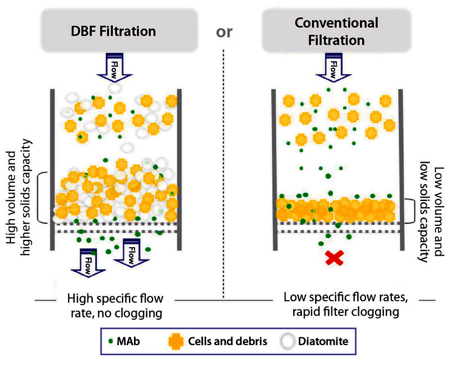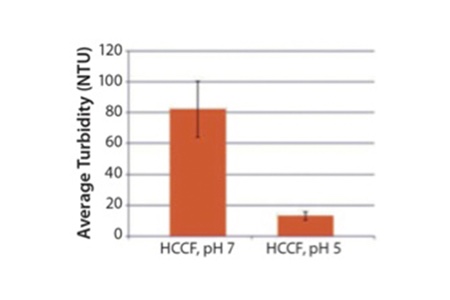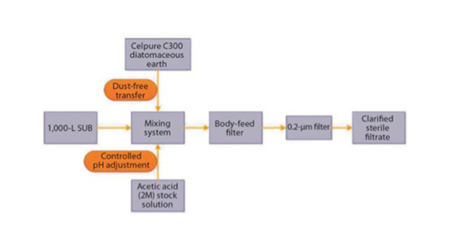During the past decade, the productivity of fed-batch mammalian cell culture systems has increased significantly. Driven by optimised strains and improved culture media, biomass concentrations have increased from 1–3g/L to 7–10g/L, particularly for monoclonal antibody (mAb) production, which facilitates the use of smaller-scale production vessels.1,2
Higher, more concentrated yields often challenge the capacities of depth filters. For volumes greater than 500 L, the use of a centrifuge has become essential to reduce both costs and waste during processing. However, the introduction of a ready-to-use clarification system that enables single-use processing at volumes of up to 2,000 L may provide a commercially viable solution and replace both centrifuges and depth filters in a single step.
High product titres derived from increased cell densities, as opposed to increased specific productivities per cell, result in a considerable solid mass that challenges commonly used harvesting techniques. And, although single-use harvesting technologies are available, frequently used depth filters tend to become blocked at lower loading capacities when processing highly concentrated biomasses. Higher contaminant concentrations also make depth filters more sensitive to batch variation. Single-use cell removal solutions such as centrifugation are available, but lack capacity.
Body feed filtration
Recently, the principles of body feed filtration (BFF), which is a well-established process used for fluid-solid separations in the plasma fractionation and beverage industries, have been tested as a substitute cell culture harvesting solution.3 The technology uses filter-aids such as diatomaceous earth (DE), which has a long history of use, to increase filter capacities.4 Together with Rentschler Biotechnologie, Sartorius Stedim Biotech attempted to evaluate the technology as a potential single-use alternative to centrifuges and depth filters.
Using Sartoclear Dynamics products, which are designed for the clarification of mammalian cell cultures in pharmaceutical production processes, optimised conditions in a 600 L cell culture production process were tested to assess the scalability of BFF technology. Specially designed for cGMP processing, Sartoclear Dynamics consists of prefilled single-use bags containing ultrapure DE (0.5–10 kg). With a new quick-connect adapter for dust-free powder transfer, the DE can be directly mixed into the cell culture fluid. This porous filter-aid prevents filter blockages and, as the system maintains a constant ratio of biomass and filter-aid, offers continuous and optimal filter performance.
How BFF works
When the solids or colloids concentration becomes too high in biological process fluids that need clarification, the filter cake on the surface of a filter becomes impermeable and blocks the filter (see Figure 1). Adding highly porous DE creates a more permeable filter cake, which prevents blockage. The amount of DE required depends on the particle concentration. For a variety of tested cultures, media and viabilities, the optimum DE concentration was found to be 40–50% of the wet cell weight (WCW), which could be reduced to 20–30% if the pH was lowered to 5.

Figure 1: Filtration principle of dynamic body feed filtration (BFF) with diatomaceous earth (DE) and conventional filtration
Furthermore, the solubility of cell debris and negatively charged impurities such as DNA and host-cell proteins decreases with pH.5 Lowering the pH leads to the formation of larger particles and makes the submicron particles present at pH 7.0 completely disappear. As such, BFF would clearly benefit from a reduced pH. In addition to the significantly decreased filter-aid concentration, tested cell culture supernatants in acidic conditions showed much clearer filtrates than their neutral counterparts (see Figure 2).
Another important factor to consider is the recovery rate at lower pH levels. Although most antibodies are stable at acidic conditions, some are likely to co-precipitate.5,6 In laboratory scale BFF tests at low pH values, recovery rates of greater than 85% were achieved.

Figure 2: Turbidity measurement of the BFF filtrates at pH 7.0 and pH 5.0 for 10 different cell cultivations with an initial turbidity of 2.396–3.235 NTU
Pilot-scale results
At Rentschler Biotechnologie, pilot-scale production tests were carried out to evaluate BFF technology for manufacturing applications (see Figure 3).7 A high cell density (17.6 x 106 cells/mL, 95% viability) Chinese hamster ovary (CHO) cell fed-batch culture (1,000 L) was used for the depth-filtration and BFF runs. The largest BFF test involved 600 L at pH 5.0 (WCW = 8%). For the scale-up experiment, seven process-scale modules were installed with a total filtration area of 1.61m2 in a universal stainless steel holder.
The filter cassettes comprise two polyethylene filter plates, which retain the DE and biomass. Cellpure C300 DE (12kg) was added to the 600 L bulk harvest and prefilled DE bags were connected with a dust-free seal-mounted adapter to a mixing bag. With Sartoclear Dynamics, the DE is directly mixed into the cell culture fluid. An innovative and validated powder handling system ensures rapid (through an 8-inch port) and dust-free DE transfer; the powder bag and adapter are connected with a functional zip mechanism for fast coupling/decoupling and clamps keep the plastic film in position and protect the rails during the process. After five minutes of gentle mixing, the DE powder had dissolved in the cell suspension; and, prior to filtration, the pH of the resulting mixture was adjusted to 5.0 and mixed for 2 h at 140rpm.
Filtration was terminated when the pressure, which increased steadily during the process, reached 1.3 bar and the crude harvest had been filtered. A high and stable flux, slightly above 300 L/m2/h, was maintained throughout and, overall, a capacity of 311 L/m2 was achieved. A very low turbidity (5–8 NTU) was recorded in the clarified harvest stream during filtration. After neutralisation, the final pool exhibited a turbidity of 41 NTU, which was considerably higher and was possibly due to inadequate dosing of the neutralisation buffer.
In a small-scale parallel test, improving the neutralisation step prevented the turbidity build-up: an integrated ready-to-use process skid is under development that will enable controlled inline pH adjustment. For example, IgG1 recovery was recorded at 85% and, in the future, an optimised neutralisation procedure and enhanced post-filtration flushing should further improve mAb recovery.
In summary, the aim of the investigation was to demonstrate the universal application of a novel single-use harvest method for mammalian (high density) cell cultures. Tests using crude harvests from different cell lines and culture conditions enabled the optimal DE concentration as a filter-aid – in relation to WCW – to be determined, which is an easily accessible cell removal/harvest-specific process. Further, a 50% reduction in the amount of filter-aid required at low-pH filtrations was identified.

Figure 3: Schematic representation of the pilot-scale BFF setup
Pilot-scale BFF experiments confirmed the laboratory scale findings: reducing the pH to 5.0 after adding DE to the crude cell-culture supernatant gives the best results in terms of filtration capacity, flux and contaminant removal.
A 600 L harvest was processed in 1 hour using only seven filtration modules. Given that a module holder can accommodate a maximum 33 modules, it is estimated that a harvest volume of approximately 3,000 L could be filtered in the same time. As such, this method facilitates the effective clarification of high cell density, crude cell culture harvests in a single-use large-scale setup.
Economically and competitively, BFF could replace centrifugation, the current method of choice for large-scale cell removal, as even very dense crude cell harvests can be clarified quickly at high flow rates. Moreover, this method is scalable and has the benefit of efficiently reducing contaminants in one step.
References
1. B. Kelley. (2009), 'Industrialization of MAb Production Technology: The Bioprocessing Industry at a Crossroads', MAbs 1(5), 443–452.
2. M. Buttler. (2005), Appl. Microbiol. Biotechnol. 68(3), 283–291.
3. M. Westoby, et al. (2011), Biotechnol. Bioeng. 108(1), 50–58.
4. E.J. Cohn, et al. (1946), J. Am. Chem. Soc. 68, 459–475.
5. M. Stucki, et al. (2008), Biologicals 36, 239–247.
6. N. Singh, et al. (2013), Biotechnol. Bioeng. 110(7), 1964–1972.
7. M. Trexler-Schmidt, et al. (2010) Biotechnol. Bioeng. 106(3), 452–461.
Sartoclear Dynamics is a registered trademark of Sartorius Stedim Biotech.




